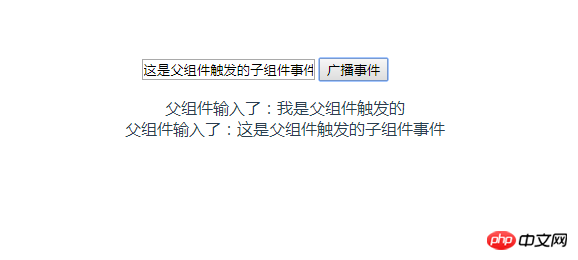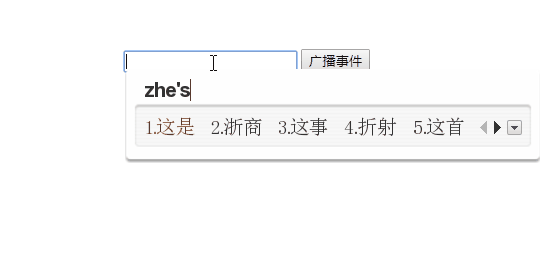 Web Front-end
Web Front-end
 JS Tutorial
JS Tutorial
 How to implement parent component click to trigger child component event in vue
How to implement parent component click to trigger child component event in vue
How to implement parent component click to trigger child component event in vue
Below I will share with you an example of how a vue parent component clicks to trigger a child component event. It has a good reference value and I hope it will be helpful to everyone.
Recently I am studying the communication problem of Vue parent and child components. I happened to encounter an event dispatch and reception between father and child. I will record it here. Here I use ref
for the child component. Register citation information. Official website explains it this way
ref is used to register reference information for elements or subcomponents. Reference information will be registered on the $refs object of the parent component. If used on a normal DOM element, the reference points to the DOM element; if used on a child component, the reference points to the component instance:
Parent component app.vue
<template>
<p id="app">
<!--父组件-->
<input v-model="msg">
<button v-on:click="notify">广播事件</button>
<!--子组件-->
<popup ref="child" ></popup>
</p>
</template>
<script>
import popup from '@/components/popup'
export default {
name: 'app',
data: function () {
return {
msg: ''
}
},
components: {
popup
},
methods: {
notify: function () {
if (this.msg.trim()) {
this.$refs.child.parentMsg(this.msg)
}
}
}
}
</script>
<style>
#app {
font-family: 'Avenir', Helvetica, Arial, sans-serif;
-webkit-font-smoothing: antialiased;
-moz-osx-font-smoothing: grayscale;
text-align: center;
color: #2c3e50;
margin-top: 60px;
}
</style>Subcomponent popup.vue
<template>
<p>
<ul>
<li v-for="item in messages">父组件输入了:{{item}}</li>
</ul>
</p>
</template>
<style>
body {
background-color: #ffffff;
}
</style>
<script>
export default{
name: 'popup',
data: function () {
return {
messages: []
}
},
methods: {
parentMsg: function (msg) {
this.messages.push(msg)
}
}
}
</script>I divided this example into several steps to interpret:
1. Bind the click event to the button element of the parent component, The event points to the notify method
2. Register a ref="child" for the child component
3. When the notify method of the parent component is processed, $refs.child is used to pass the event The parentMsg method for the child component also carries the parameter msg in the parent component
4. After the child component receives the event from the parent component, it calls the parentMsg method and puts the received msg into the message array
The running results are as follows:


The above is what I compiled for everyone. I hope it will be helpful to everyone in the future.
Related articles:
Implementing user permission control in Vue2.0
Detailed explanation of how to implement vuex (detailed tutorial)
Implement WeChat payment through vue.js
The above is the detailed content of How to implement parent component click to trigger child component event in vue. For more information, please follow other related articles on the PHP Chinese website!

Hot AI Tools

Undresser.AI Undress
AI-powered app for creating realistic nude photos

AI Clothes Remover
Online AI tool for removing clothes from photos.

Undress AI Tool
Undress images for free

Clothoff.io
AI clothes remover

Video Face Swap
Swap faces in any video effortlessly with our completely free AI face swap tool!

Hot Article

Hot Tools

Notepad++7.3.1
Easy-to-use and free code editor

SublimeText3 Chinese version
Chinese version, very easy to use

Zend Studio 13.0.1
Powerful PHP integrated development environment

Dreamweaver CS6
Visual web development tools

SublimeText3 Mac version
God-level code editing software (SublimeText3)

Hot Topics
 How to use bootstrap in vue
Apr 07, 2025 pm 11:33 PM
How to use bootstrap in vue
Apr 07, 2025 pm 11:33 PM
Using Bootstrap in Vue.js is divided into five steps: Install Bootstrap. Import Bootstrap in main.js. Use the Bootstrap component directly in the template. Optional: Custom style. Optional: Use plug-ins.
 How to add functions to buttons for vue
Apr 08, 2025 am 08:51 AM
How to add functions to buttons for vue
Apr 08, 2025 am 08:51 AM
You can add a function to the Vue button by binding the button in the HTML template to a method. Define the method and write function logic in the Vue instance.
 How to use watch in vue
Apr 07, 2025 pm 11:36 PM
How to use watch in vue
Apr 07, 2025 pm 11:36 PM
The watch option in Vue.js allows developers to listen for changes in specific data. When the data changes, watch triggers a callback function to perform update views or other tasks. Its configuration options include immediate, which specifies whether to execute a callback immediately, and deep, which specifies whether to recursively listen to changes to objects or arrays.
 What does vue multi-page development mean?
Apr 07, 2025 pm 11:57 PM
What does vue multi-page development mean?
Apr 07, 2025 pm 11:57 PM
Vue multi-page development is a way to build applications using the Vue.js framework, where the application is divided into separate pages: Code Maintenance: Splitting the application into multiple pages can make the code easier to manage and maintain. Modularity: Each page can be used as a separate module for easy reuse and replacement. Simple routing: Navigation between pages can be managed through simple routing configuration. SEO Optimization: Each page has its own URL, which helps SEO.
 How to reference js file with vue.js
Apr 07, 2025 pm 11:27 PM
How to reference js file with vue.js
Apr 07, 2025 pm 11:27 PM
There are three ways to refer to JS files in Vue.js: directly specify the path using the <script> tag;; dynamic import using the mounted() lifecycle hook; and importing through the Vuex state management library.
 How to return to previous page by vue
Apr 07, 2025 pm 11:30 PM
How to return to previous page by vue
Apr 07, 2025 pm 11:30 PM
Vue.js has four methods to return to the previous page: $router.go(-1)$router.back() uses <router-link to="/" component window.history.back(), and the method selection depends on the scene.
 How to use vue traversal
Apr 07, 2025 pm 11:48 PM
How to use vue traversal
Apr 07, 2025 pm 11:48 PM
There are three common methods for Vue.js to traverse arrays and objects: the v-for directive is used to traverse each element and render templates; the v-bind directive can be used with v-for to dynamically set attribute values for each element; and the .map method can convert array elements into new arrays.
 How to jump to the div of vue
Apr 08, 2025 am 09:18 AM
How to jump to the div of vue
Apr 08, 2025 am 09:18 AM
There are two ways to jump div elements in Vue: use Vue Router and add router-link component. Add the @click event listener and call this.$router.push() method to jump.





